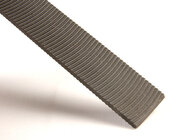A visit to your favorite hardware store should net you a fine-tooth mill or flat file for not too much money. 9-10" long (not counting the handle) will be peachy. If they have a "file card" with the files (a wire brush-like tool to clean the file), buy one as well, or from Amazon. Here's an article-
The design of the flat files is mostly tapered at width and thickness towards the endpoint of the file. It is a great tool with teeth on both sides. Generally used to sharpen the blades and knives. While the mill files are featured with one safe edge. The cut pattern of the mill files is always...

benchmarkabrasives.com
Files typically cut in one direction, pushing the file so the the handle is at the rear in the direction of travel. (Best to pick up the file at the end of that forward stroke to start the next stroke.)
With light to medium pressure (let the file do the work), start at one end of your tool rest and go down to the other end, holding the file just a little bit diagonal to the tool rest surface. Most of the length of the file should be on the rest. File over the top of your knicks and dings, don't file just the dings. You need to bring the whole surface of the rest down evenly to the level of the dings to prevent high and low spots on the rest. A metal ruler/straight edge held to the rest can help make sure you're keeping thing in one plain. Tweak each stroke a hair to keep following over the shape of the rest. When the knicks are gone, a few strokes with a piece of 220 grit on a block of wood will polish it up a bit more (optional process).
If this is the first time, it will take a few minutes (or more) to clean it up. If you do a few strokes at the beginning of each turning session if you feel knicks, it'll always be in good shape. Wipe it clean with a rag, then give a couple strokes of candle/paraffin wax if you'd like. Wax will not prevent knicks and dings, it only makes a slick surface to move the tool.
Any tools that have sharp, angular corners (skews, parting tools, bedans, etc.), knock those hard corners off on your fine grinding wheel, giving them a bit of a radius. This will help preserve the surface of your rest. Round shape gouges won't ding the rest. If you are otherwise happy with your tool rest shape and how your hand feels against it, don't replace it just for this. A hobby turner maintaining the tool rest will use that tool rest for their whole life.
Note- it took me longer to write this than it will take you to file it smooth the first time!







